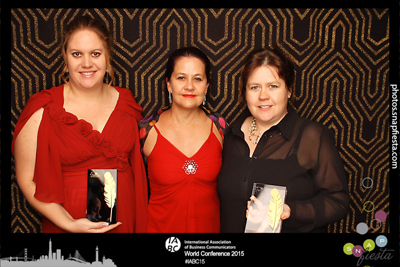UFS Communication and Brand Management receives two prestigious international awards

Lelanie de Wet, Lacea Loader and Leonie Bolleurs |
The Department of Communication and Brand Management at the University of the Free State (UFS) received two of the six Gold Quill Awards – that were awarded to South African companies and institutions - at the International Association of Business Communicator’s (IABC) Excellence Gala ceremony in San Francisco, US on 15 June 2015.
The awards ceremony formed part of the 2015 IABC World Conference, which took place from 14-17 June 2015. The department received a Gold Quill Excellence Award for its social media campaign, UFS #FaceOfFacebook and a Gold Quill Merit Award for the B Safe Take Action campaign.
From the 15 countries that entered, a total of 120 Gold Quill Excellence awards and 189 Gold Quill Merit awards were awarded. Other South African award winners included Barclays Africa Group Limited, Mediclinic and the Cape Peninsula University of Technology (CPUT).
This is the second year in a row that the UFS has been recognised by the IABC for its communication projects. In 2014, the department was awarded the Jake Wittmer Research Award for a Stakeholder Perception Audit conducted in February 2014. The audit was considered – by the IABC - as one of the best breakthrough strategies used by a university to measure the perceptions of its stakeholders.This made the UFS the first tertiary institution in Africa to receive the research award. The stakeholder perception audit also received an Africa Gold Quill in 2014.
"Being recognised by a global association such as the IABC for the second time, is a great honour and I am very proud of what my colleagues have achieved by entering the two campaigns. Winning the awards is a true indication of what can be done when a team of expert communicators is committed towards engaging their target audiences with campaigns that speak of quality and innovation. The fact that the UFS is one of only two tertiary education institutions in the country to receive these prestigious awards, makes it even more special," said Lacea Loader, Director: Communication and Brand Management at the UFS.
IABC World and Africa conferences 2015
The IABC is a global membership association with a network of 12 000 members in more than 80 countries, representing many of the Global Fortune 500 companies. It serves professionals in the field of business communication, bringing together the profession’s collective disciplines.
With the theme: Changing landscape: Informing the future, the 2015 world conference was attended by over 1 200 delegates from across the world. Delegates were offered an opportunity for learning, discovering, and connecting. Loader also made a presentation entitled ‘Award-winning measurement endorses sound reputation management strategy’ at the world conference.
The department will also be receiving two Africa Gold Quill Awards from the Africa chapter of the IABC for the same campaigns on 30 July 2015 in Johannesburg.
UFS #FaceOfFacebook Campaign
The university received a Gold Quill Excellence Award for its social media campaign, UFS #FaceOfFacebook. This initiative originated in the university’s commitment to its Human Project, which sets the standard for good behaviour and care.
Lelanie de Wet, Manager: Social Media and Website Content and project leader of UFS #FaceOfFacebook, said the project was born from the need to communicate with students. Thus a virtual friend, #FaceOfFacebook, was created. “Yearly auditions are being held to choose the new face representing the UFS on Facebook. Short video clips of the #FaceOfFacebook – whether it is attending events or communicating important messages - are posted on the UFS Facebook page. The successful candidate holds the title #FaceOfFacebook for 12 months.
“When I look at a campaign such as #FaceOfFacebook, from the time it took its first tentative steps in 2013, and see how it inspired staff and students alike, my heart swells with pride. Often you can see the impact you have made only in retrospect. The ripples you send into the world will inevitably create waves,” she said.
B Safe Take Action Campaign
The B Safe Take Action campaign of the university received a Gold Quill Merit award from the IABC.
The campaign was activated in September 2013. “It targeted on- and off-campus students and staff, aiming to create social ownership of personal safety, and to raise awareness of the safety measures put in place by the university,” said Leonie Bolleurs, Manager: Internal Communication and project manager of the campaign.
The campaign looked at a number of safety aspects, focusing not only on crime but also on being safe from road accidents and stress/burnout.
It is the second time this year that the BSafe campaign has been recognised for its innovative strategy. Earlier this year it received a PRISM Award (Gold) from the Public Relations Institute of Southern Africa (PRISA). The annual PRISM Awards are about recognising and celebrating great public relations campaigns.